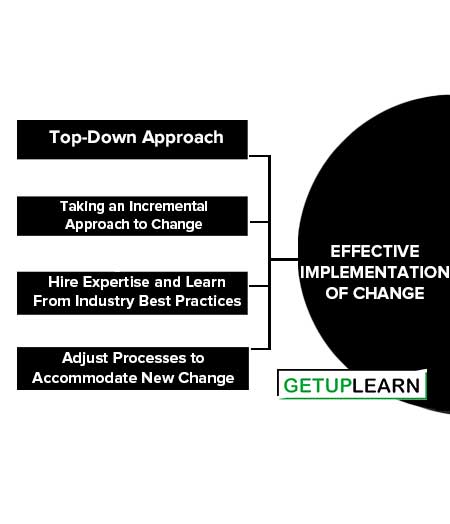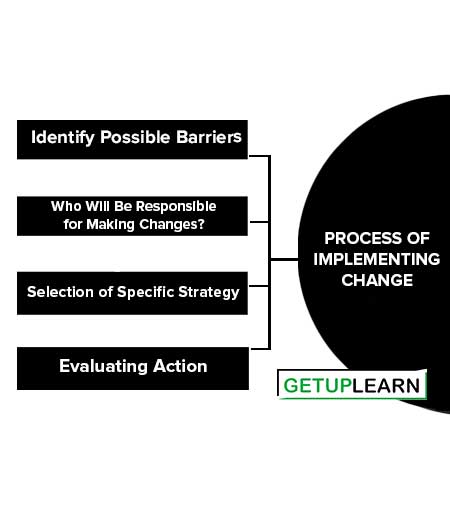Table of Contents
Effective Implementation of Change in Organizations
Implementing organizational change to facilitate an organization’s goals and objectives presents many challenges to gain company-wide acceptance. Taking a holistic approach to the process can assist companies with adopting the right mindset right from the get-go. The following represents some basic guidelines for implementing organizational change:
- Top-Down Approach
- Taking an Incremental Approach to Change
- Hire Expertise and Learn From Industry Best Practices
- Adjust Processes to Accommodate New Change

Top-Down Approach
It is very important that senior management embrace organizational change and remain accountable throughout the process.
Strong leadership helps to create enthusiasm and overcome unwilling attitudes. Leaders who are respected and admired can strongly influence other team members. A strategic planning process to unite leadership in the affected business units can greatly assist in orienting to the new direction.
Taking an Incremental Approach to Change
The evaluation stage for implementing organizational change allows an organization to model the proposed change process, scope and bound the deliverables, and establish a feedback process. Implementing organizational changes in incremental stages provides the opportunity for close monitoring and iterative refinement.
By involving the affected organization members in the process, those who are most likely to be affected by the change can contribute to shaping the outcome. Once people are involved, attitudes can quickly change from resistance to support.
Hire Expertise and Learn From Industry Best Practices
Change management professionals have previous business experience and can identify problems and oversights. Employing the services of suitably qualified personnel who can assess company requirements, tailor change initiatives, and benchmark the implementation stage provides an opportunity for companies to avoid costly mistakes.
Change management professionals can expand the business horizon by introducing industry best practices and referencing previous case studies that are relevant to the industry.
Adjust Processes to Accommodate New Change
Companies that implement organizational change often fail to adequately assess the impact that changes can have on existing processes. New infrastructure and equipment are often required to sustain new changes.
This includes training staff members to adequately use the equipment. The change management process should include an audit of existing processes to identify areas for risk prior to implementation.
Modern progressive business practice requires companies to adopt a flexible approach to changing markets and consumer preferences. As companies merge, streamline, exit the market at the end of the product life cycle, or face new competition, implementing change in an organization is necessary to stay competitive and profitable.
When a reorientation of central core business objectives takes place, it is important that a change management framework accompanies the new business direction. This can greatly assist a company to achieve its new objectives.
Process of Implementing Change
These are the following steps in the process of implementing change:
- Identify Possible Barriers
- Who Will Be Responsible for Making Changes?
- Selection of Specific Strategy
- Evaluating Action

Identify Possible Barriers
First, managers identify possible barriers to change at all levels.
Who Will Be Responsible for Making Changes?
The second step is to decide who will be responsible for actually making the changes. External change agents may be used, which are outside consultants who specialize in managing change. Internal change agents are managers from within that are knowledgeable about the situation.
Selection of Specific Strategy
The third step is deciding which specific strategy to use to unfreeze, change, and refreeze the organization per Lewin’s model.
Top-down change is implemented by managers at a high level in the organization, knowing that the change will reverberate at all organizational levels. Bottom-up change is implemented by employees at low levels and will gradually rise throughout the organization.
Evaluating Action
Evaluating the Action is the final step in the process. Managers assess the degree to which the changes have accomplished the desired objectives.
FAQs about the Effective Implementation of Change in Organizations
What is effective organizational change?
The following represents some basic guidelines for implementing organizational change:
1. Top-Down Approach
2. Taking an Incremental Approach to Change
3. Hire Expertise and Learn From Industry Best Practices
4. Adjust Processes to Accommodate New Change.
What is the process of implementing change?
1. Identify Possible Barriers
2. Who Will Be Responsible for Making Changes?
3. Selection of Specific Strategy
4. Evaluating Action.
steps the process of implementing change.
